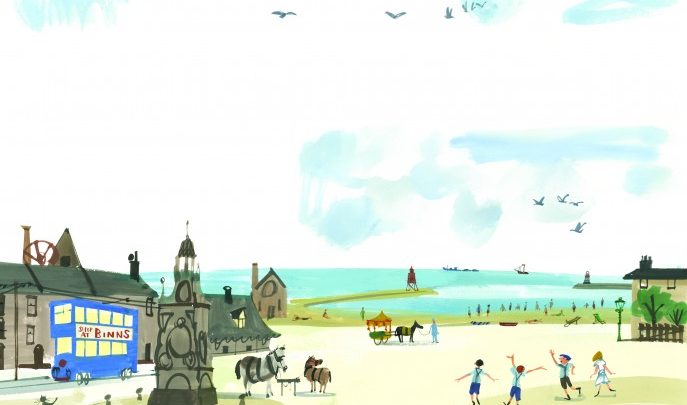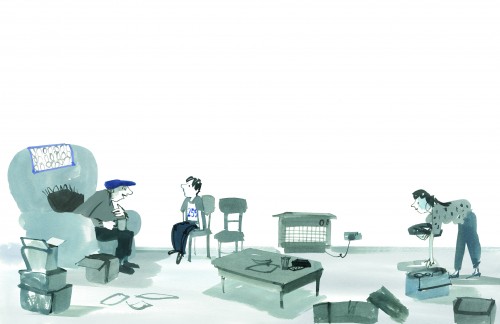KS2 Book Topic: Inspire Creative Writing with a Race Against Time in Harry Miller’s Run

See how memories and the past can make children appreciate every passing moment, no matter how quickly they seem to be rushing by…

- by Clare Pearson
- Headteacher at Summerbank Primary School in Stoke

Have you ever had a moment of madness? I have. Last year, mine involved agreeing to do the Great North Run.
For many people this might not seem a mad idea, for me (never having made it more than six miles without being at the point of collapse) it was definitely bonkers. In my naivety and innocence I thought it was 10 miles (note: do your research first).
It was only later I realised I’d signed up for a half marathon. That’s the thing about mad ideas: they are exhilarating at the time, but even more so in memory – that moment when you look back and say: ‘Did I really do that?’.
In Harry Miller’s Run, David Almond perfectly captures this euphoria, sweeping the readers up and carrying them into the stories of two boys and their own memorable runs.
“That’s reet, lad! Run! There’s a wolf at your tail! Run for your lovely life!” cries the ancient (Liam’s words) Harry Miller as he stands with his Zimmer frame watching his young neighbour race along the street.
Liam is in training; he’s going to complete the Junior Great North Run and can’t wait for the experience. He certainly doesn’t want to spend the day cooped up helping Harry pack his belongings to move into a nursing home, not when he could be outside with the wind in his face and the imagined cheers of the crowd.
But Harry hasn’t always been ancient; aged 11, he and a group of friends ran their own half marathon, and as Liam discovers, joy does not just happen in the moment, it continues to live inside each of us, however old.
This poignant and uplifting story makes a great choice for both English and cross-curricular work with Key Stage 2.
As children engage with Harry’s ‘story within a story’, they will be transported back to the simpler times of his youth, contrasting with their own lives and that of Liam’s.
The beautiful illustrations by Salvatore Rubbino build on the concept of living memories through his use of colour – with vibrant depictions of the past contrasting with the black-and-white depictions of present day.

1 | Introducing the text
A background knowledge of the Great North Run isn’t essential, but pre-cueing will help aid comprehension. Begin by writing a prose piece including various facts about the run, for example: length, fastest time, number of competitors, children’s version, location (check greatrun.org/great-north-run). Now put children into mixed-ability groups and embark on a quiz.
For round one, provide a set of questions based on the Great North Run (which you know will be answered by the text you have prepared). Having collected their answer sheets, explain that in round two they will have the same set of questions, but will this time have a help sheet that contains all the answers. They can now use their comprehension skills to have a second attempt.
Alternatively, have the paragraphs posted up around the classroom/playground for children to go off and discover.
2 | Writing opportunities
At the beginning of the text, Liam imagines how he will feel during the race ‘belting round the quayside…all the running kids, the cheering crowds…sprinting to the finish line…laughing and yelling’. This stream of consciousness makes an excellent basis for poetry writing.
Children work best when writing about what they know – what excites them. Use each of the senses as headings on the board and begin by discussing Liam’s description – what are the reasons for his excitement? Use evidence from the text to add notes.
Some will immediately identify with his feelings, but for others more concrete stimuli will be required. Play a clip of the Great North Run on the whiteboard and encourage children to be observers, to go beyond the general and look carefully for details.
As a final stimulus, let them live the poem – go outside and run for 10 minutes, keeping thinking about their senses, before returning to the classroom and adding their new thoughts.
You now have a resource bank on the board that will support your weaker writers and act as a stimuli for the more creative.
Providing a structure will help add coherence to the writing and get children started – a senses list poem works well here:
I can hear the sound of tramping feet I can hear the sound of the cheering crowd
Demonstrate how the inclusion of other poetic devices (it᾿s useful to display a list, for example – simile, metaphor, personification, onomatopoeia, alliteration, assonance, hyperbole, improved word choice) can raise the quality of the poem.
I can hear the sound of feet like thunder I can hear the sound of a million voices urging me along
Here you can play around by replacing one sense word with another, a particularly effective technique for evoking atmosphere (Pie Corbett calls this ‘synethesia’).
I can taste the sound of feet like thunder I can see the scent of a million voices urging me along
3 | Fiction and non-fiction
Non-fiction: a boxful of memories
This text constantly revisits the theme of time and the importance of memories. When planning his move to the nursing home, Harry disposes of all material possessions apart from a box full of papers.
When Mum and Liam start to sort through these, they discover the story of Harry’s life, told through certificates, photographs and letters, and later supplemented by Harry’s own recollections as he is transported back in time by the various documents, reliving each snapshot of his past.
There is a rich resource here for development into biography and autobiography work, children could be supported to:
- Write Harry’s biography using details taken from the text
- Create their own memory box and accompanying autobiography or journal
- Interview an older member of their family or community and work with them to create a memory box that illustrates their own story
- Imagine themselves as an older Liam and consider how his life develops; what would he share with the younger generation when he is in his 80s?
Fiction: a sound story
Both Harry and Liam end their runs at the seaside. Use this setting as a stimulus for children to create a story of their own. You will need a film clip that takes place by the sea for this (a great resource would be the very short film Lucky Dip).
Give each child a basic timeline to work with, and play the film without showing it to them or mentioning the setting. Simply model listening to the first part of the clip, noting down the sounds heard (music, clicking, gulls, etc).
Play the rest of the clip getting children to continue the task. Discuss findings, then play it a second time for children to add anything they have missed.
What questions arise from their listening? Who or what might they expect to see on screen? Where do they think this story is taking place? To which genre does this story belong?
Give children time to work either individually or in pairs to prepare a story plan before retelling their version to a partner for constructive feedback and improvements.
After the children have completed this you may (or may not) want to reveal the original film for them to compare with their own interpretation. This technique can be applied to any genre of fiction writing – The Literacy Shed has a wealth of video clips to support this work.
4 | Cross-curricular opportunities
Building homes Harry and Liam live in a close-knit community. As part of a D&T project, design and build houses complete with miniature gardens to match (in the style of Harry’s ‘neat little garden’). Computing links can be made through the use of design packages to support at the planning stage.
The RHS website has useful activity prompts and resource ideas for creating miniature gardens.
Just one Cornetto
Harry’s run is partly catalogued (and fuelled) by the enigmatic master ice cream maker, Mr Gabrieli. This kind-hearted gelato fairy-godfather directs the children when lost, provides sustenance and takes photographs of the victorious four.
Amaze and wow your class by helping them to make ice-cream without the aid of a freezer as part of the science curriculum – all you need is ice, salt and plenty of energy! Instructions can be found on the Science Museum website.
Changing times
While this book tells the tale of a magical day in Harry’s youth, readers today will identify a number of contrasts between the freedom allowed to the children – disappearing at dawn and returning only when hungry – and expectations within our own society.
Today’s more cynical reader might have concerns over the number of strangers the children trust and accept help from, the lack of knowledge of their parents about where they are and the distances they travel unaccompanied.
All of this provides excellent opportunities for discussion through PSHE and circle-time work. Children could be prompted to think about:
- Is the age limit of 17 to compete in the Great North Run appropriate, and why does it exist?
- Should Harry have given his address to Mr Gabrieli?
- How has modern technology changed children’s lives between Harry’s time and Liam’s?
- Did the children face any dangers on their adventures? Did they make good choices in these situations?
- What does Liam learn from his time talking to Harry?
- Has Harry had a ‘good’ life?
5 | Bringing the topic to a close
Liam and Harry’s story ends with Liam taking part in his first Junior Great North Run before watching the runners in the main race.
While cheering the competitors along, he is astonished to glimpse four smaller figures wearing old-fashioned clothes, laughing and dodging through the crowds of adults – a magical moment, though no more magical than the moments being created by each of those taking part.
Bring this book topic to a close by planning your own great sporting event for the children to take part in; a competitive race, or maybe a charity run complete with fancy dress.
Invite parents and friends along and the local ice-cream van too (or maybe put your class’ ice-cream making to the test and have children sell their own from a stall decorated just like Mr Gabrieli’s cart).
Make sure you take lots of photographs to capture all of those special moments and to put on display, and provide each child with their own certificate, just like Harry’s.
However you decide to bring this learning to a close, do so knowing you will have helped make memories that will last, and that one day in the far-off future, someone will reminisce about them with a smile on their face.
Capturing memories
The theme of time passing is present throughout the story. Mum tells Liam ‘You have all the time in the world’. Time moves quickly and while the big memories are never forgotten, the little moments can easily be lost.
Start a Memory Jar as a class (or children could do this individually as a personal project), note down anything that happens through the year that causes a smile on a slip of paper and place in the jar. These memories can then be opened, enjoyed and celebrated at the end of the year.
Clare Pearson is deputy headteacher at Summerbank Primary School in Stoke. Previously, Clare was the Primary Advisory English Teacher for Stoke-on-Trent.










